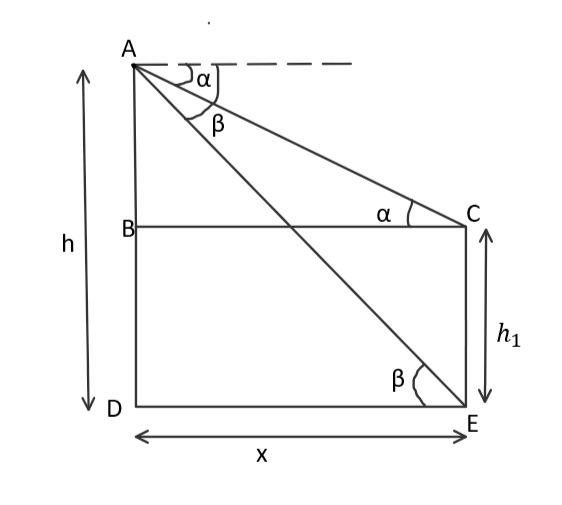
From the top of a hill h meters high, the angles of depressions of the top and bottom of a pillar are $\alpha $ and $\beta $, respectively. The height (in meters) of the pillar is?
A. $\dfrac{{h[\tan \beta - \tan \alpha ]}}{{\tan \beta }}$
B.$\dfrac{{h[\tan \alpha - \tan \beta ]}}{{\tan \alpha }}$
C. $\dfrac{{h[\tan \alpha + \tan \beta ]}}{{\tan \beta }}$
D. $\dfrac{{h[\tan \alpha + \tan \beta ]}}{{\tan \alpha }}$
Answer
220.8k+ views
Hint: Since the problem is based on applications of trigonometry hence, it is necessary to draw the figure for better visualization of the problem. Here, we will use proper trigonometric identities and ratios and then equate them to get the required dimension of a pillar and find out the solution to a given problem.
Complete step by step Solution:
The angles of depression of the top and bottom of a pillar $\alpha $ and $\beta $ respectively (given).
Let the height of the hill $(AD)$ be $h$ and the height of the pillar $(CE)$ be ${h_1}$ as shown in the figure.
Let the distance between the feet of the hill and pillar $(DE)$ be $x$.

In \[\vartriangle ABC\],
$\tan \alpha = \dfrac{P}{B} = \dfrac{{AB}}{{BC}}$
From the figure, it is clear that $AB = h - {h_1}$ and $BC = x$, substitute these values in the above expression, we get
$\tan \alpha = \dfrac{{h - {h_1}}}{x}$
$x = \dfrac{{h - {h_1}}}{{\tan \alpha }}$ …. (1)
In \[\vartriangle ADE\],
$\tan \beta = \dfrac{P}{B} = \dfrac{{AD}}{{DE}}$
From the figure, it is clear that $AD = h$ and $DE = x$, substitute these values in the above expression, we get
$\tan \beta = \dfrac{h}{x}$
$x = \dfrac{h}{{\tan \beta }}$ …. (2)
Equating eq. (1) and (2), we get
$\dfrac{{h - {h_1}}}{{\tan \alpha }} = \dfrac{h}{{\tan \beta }}$
By Cross-multiplication,
$h.\tan \beta - {h_1}.\tan \beta = h.\tan \alpha $
$h.\tan \beta - h.\tan \alpha = {h_1}.\tan \beta $
Taking common$h$from the above expression, we get
$h(\tan \beta - \tan \alpha ) = {h_1}.\tan \beta $
${h_1} = \dfrac{{h(\tan \beta - \tan \alpha )}}{{\tan \beta }}$
Thus, the Height of the pillar is $\dfrac{{h(\tan \beta - \tan \alpha )}}{{\tan \beta }}$ .
Hence, the correct option is A.
Note: In the problems based on the application of trigonometry, apply the required trigonometric ratios to get the accurate solution to the problem. Sometimes, the problem seems to be complex while analyzing the problem hence, it is advised to draw a figure and calculate ratios one by one carefully.
Complete step by step Solution:
The angles of depression of the top and bottom of a pillar $\alpha $ and $\beta $ respectively (given).
Let the height of the hill $(AD)$ be $h$ and the height of the pillar $(CE)$ be ${h_1}$ as shown in the figure.
Let the distance between the feet of the hill and pillar $(DE)$ be $x$.

In \[\vartriangle ABC\],
$\tan \alpha = \dfrac{P}{B} = \dfrac{{AB}}{{BC}}$
From the figure, it is clear that $AB = h - {h_1}$ and $BC = x$, substitute these values in the above expression, we get
$\tan \alpha = \dfrac{{h - {h_1}}}{x}$
$x = \dfrac{{h - {h_1}}}{{\tan \alpha }}$ …. (1)
In \[\vartriangle ADE\],
$\tan \beta = \dfrac{P}{B} = \dfrac{{AD}}{{DE}}$
From the figure, it is clear that $AD = h$ and $DE = x$, substitute these values in the above expression, we get
$\tan \beta = \dfrac{h}{x}$
$x = \dfrac{h}{{\tan \beta }}$ …. (2)
Equating eq. (1) and (2), we get
$\dfrac{{h - {h_1}}}{{\tan \alpha }} = \dfrac{h}{{\tan \beta }}$
By Cross-multiplication,
$h.\tan \beta - {h_1}.\tan \beta = h.\tan \alpha $
$h.\tan \beta - h.\tan \alpha = {h_1}.\tan \beta $
Taking common$h$from the above expression, we get
$h(\tan \beta - \tan \alpha ) = {h_1}.\tan \beta $
${h_1} = \dfrac{{h(\tan \beta - \tan \alpha )}}{{\tan \beta }}$
Thus, the Height of the pillar is $\dfrac{{h(\tan \beta - \tan \alpha )}}{{\tan \beta }}$ .
Hence, the correct option is A.
Note: In the problems based on the application of trigonometry, apply the required trigonometric ratios to get the accurate solution to the problem. Sometimes, the problem seems to be complex while analyzing the problem hence, it is advised to draw a figure and calculate ratios one by one carefully.
Recently Updated Pages
The angle of depression of the top and the bottom of class 10 maths JEE_Main

Find the value of sin 50 circ sin 70 circ + sin 10 class 10 maths JEE_Main

The amount of work in a leather factory is increased class 10 maths JEE_Main

The side BC of a triangle ABC is bisected at D O is class 10 maths JEE_Main

The circumference of the base of a 24 m high conical class 10 maths JEE_Main

Mutually Exclusive vs Independent Events: Key Differences Explained

Trending doubts
JEE Main 2026: Application Form Open, Exam Dates, Syllabus, Eligibility & Question Papers

JEE Main Syllabus 2026: Download Detailed Subject-wise PDF

JEE Main Marks vs Percentile vs Rank 2026: Calculate Percentile and Rank Using Marks

JEE Main Previous Year Question Papers (2014–2025) with Answer Keys and Solutions

Exothermic Reactions: Real-Life Examples, Equations, and Uses

JEE Main Cut Off 2026 - Expected Qualifying Marks and Percentile Category Wise

Other Pages
NCERT Solutions For Class 10 Maths Chapter 12 Surface Area And Volume

NCERT Solutions for Class 10 Maths Chapter Chapter 13 Statistics

NCERT Solutions for Class 10 Maths Chapter 11 Areas Related to Circles 2025-26

Pregnancy Week and Due Date Calculator: Find How Far Along You Are

Complete List of Class 10 Maths Formulas (Chapterwise)

NCERT Solutions for Class 10 Maths Chapter 15 Probability




